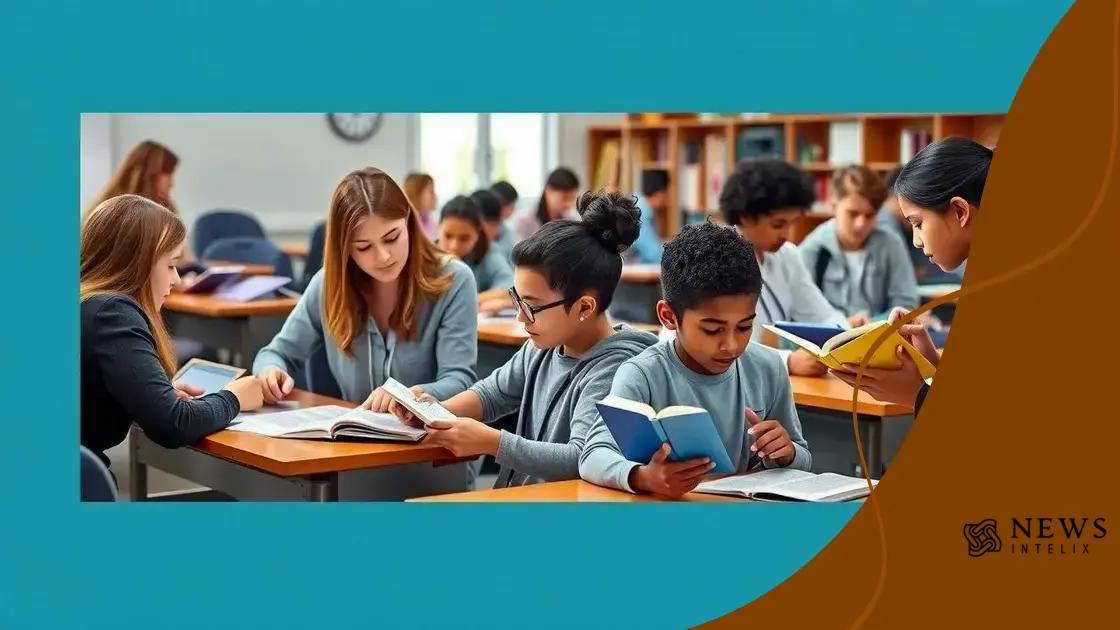Digital textbooks replace print in pilot programs

Digital textbooks replace print materials by offering interactive, personalized learning experiences, which enhance student engagement and accommodate diverse learning styles while addressing challenges like device accessibility and internet connectivity.
Digital textbooks replace print in various pilot programs, revolutionizing how students engage with learning materials. Have you wondered how this shift impacts education?
What are digital textbooks?
Digital textbooks are electronic versions of traditional print textbooks. These digital formats provide students with interactive and engaging learning experiences. Many people are curious about how digital textbooks differ from printed ones and what benefits they can offer.
Key Features of Digital Textbooks
Digital textbooks come with various features that enhance learning. They often include multimedia content, such as videos and interactive quizzes, making lessons more engaging for students. Plus, they are easily accessible from multiple devices like tablets, laptops, and smartphones, allowing for flexibility in learning.
- Interactive elements improve student engagement.
- Access on multiple devices increases convenience.
- Search functionality allows quick finding of information.
- Regular updates ensure content is current.
Aside from these features, digital textbooks often reduce costs over time. Schools can save money on printing and distributing physical books. Additionally, students can save money by purchasing digital versions, which are typically priced lower than print copies. This is particularly important for families on a budget who want to provide their children with the best educational resources.
Accessibility and Learning Styles
Another advantage of digital textbooks is their accessibility. Students with learning disabilities can benefit from features such as text-to-speech and adjustable font sizes. This can transform how they interact with content, making it easier for all students to learn.
Moreover, digital textbooks support various learning styles. For instance, visual learners benefit from images and videos, while auditory learners can listen to narrated texts. This flexibility encourages a personalized learning experience that can cater to the needs of different students.
The benefits of digital over print textbooks
Choosing digital textbooks over print ones brings several advantages that can enhance the learning experience for students. These benefits range from convenience to improved interactivity, making education more accessible and effective.
Cost Efficiency
One significant benefit is the cost savings associated with digital textbooks. Often, digital versions are more affordable than their print counterparts. Schools can reduce expenses on printing and distribution while students can save money on purchasing books.
- Lower purchase prices compared to print textbooks.
- Reduced shipping and handling costs.
- No need for physical storage space.
- Updates and new editions are often free or low-cost.
Moreover, implementing digital textbooks can provide financial relief for cash-strapped educational institutions. By minimizing physical materials, schools can allocate funds more efficiently—for example, investing in technology and other resources that directly enhance learning.
Enhanced Learning Experience
Digital textbooks come with interactive features that help engage students better than traditional print books. For instance, many digital textbooks offer videos, quizzes, and hyperlinks that enrich the content and facilitate active learning. Students who use these digital resources are more likely to participate actively in their education.
Additionally, with integrated multimedia, students can learn in ways that cater to different learning styles. Visual learners benefit from images, while auditory learners can enjoy audio explanations within the text. Each student can personalize their learning experience, often leading to improved retention and understanding of the material.
Furthermore, digital textbooks can be updated easily, ensuring that students always have the most current information available. This aspect is particularly crucial in fast-changing fields of study, where timely information is vital for a comprehensive understanding.
How pilot programs are transforming education

Pilot programs are essential in shaping how education evolves with technology. These programs allow schools to test digital textbooks in controlled environments, providing insights into their effectiveness before wider implementation.
Testing and Feedback
One major benefit of pilot programs is the ability to gather feedback from teachers and students. This feedback can help identify what works well and what needs improvement. Teachers often create better lesson plans using digital textbooks because they can include interactive elements that engage students more effectively. Students, in turn, can contribute valuable insights into how they learn best with these resources.
- Identifying successes and challenges in real-time.
- Adjusting content based on user experience.
- Improving teacher training and support.
- Enhancing student engagement through feedback.
By piloting new technologies in education, schools can adapt their approaches to suit student needs better. This flexibility means that learning resources can evolve as technology does, moving towards more innovative practices in classrooms.
Building Partnerships
Another aspect of pilot programs is the collaboration between schools, technology companies, and educational stakeholders. These partnerships can lead to improved resources and support for both teachers and students. For example, companies often offer training and support during the pilot phase to ensure that teachers are comfortable with using digital textbooks.
These cooperative programs pave the way for better communication, sharing best practices among educators. Schools that participate in pilot programs often become part of a larger community focused on innovation. They learn from each other’s experiences, leading to broader changes in educational strategies.
Challenges in implementing digital textbooks
Implementing digital textbooks in schools comes with several challenges that need attention. While these resources offer numerous benefits, the transition from print to digital can be complex and requires careful planning.
Technical Issues
One major challenge schools face is ensuring that the necessary technology is available. Not all students have access to devices like tablets or laptops, which can hinder their ability to participate fully in a digital learning environment. Additionally, schools must invest in reliable internet connections. Without adequate bandwidth, students may experience difficulties accessing digital content.
- Inadequate access to devices for all students.
- Insufficient internet connectivity in some areas.
- Compatibility issues with software or platforms.
- Need for ongoing technical support and training.
These technical obstacles can lead to frustration for both teachers and students, highlighting the importance of a thorough implementation strategy that accounts for these needs.
Resistance to Change
Another challenge is the resistance some educators may have towards moving away from traditional print materials. Many teachers feel comfortable with print textbooks and might be hesitant to adopt new technologies. This reluctance can stem from a lack of familiarity with digital tools or concerns about how effective they are compared to traditional methods.
Overcoming this resistance requires effective training and support. Educators need to see the potential benefits of digital textbooks and how they can enhance learning. Professional development programs can play a key role in easing this transition, allowing teachers to gain confidence in using new resources.
Furthermore, some educators may worry about maintaining student engagement through digital formats. Addressing these concerns head-on can facilitate a smoother transition and foster a more positive attitude towards digital learning tools.
Future trends in digital learning resources
The future of digital learning resources looks promising as technology continues to evolve. Schools and educators are taking advantage of new tools that enhance the learning experience. This shift toward digital materials is set to transform how students engage with content.
Personalized Learning
One major trend is the move toward personalized learning. Digital resources can adapt to each student’s learning style and pace. This individualized approach helps students grasp concepts more effectively. For example, adaptive learning platforms adjust the difficulty of tasks based on real-time performance, ensuring that students receive the right level of challenge.
- Tailored content based on learning preferences.
- Real-time feedback that helps students improve.
- Flexible pacing to accommodate different learners.
- Increased student motivation through customized experiences.
With personalized learning, students can take ownership of their education and progress through materials at their own speed, making learning more engaging.
Integration of Artificial Intelligence
Another exciting trend is the integration of artificial intelligence (AI) into digital textbooks and learning platforms. AI technology can analyze student interactions to offer insights and recommendations for improvement. This means teachers can receive valuable information about student progress without manually tracking every detail.
Furthermore, AI-driven systems can offer guided practice and support for students who struggle with certain topics. This level of support allows for targeted interventions that can lead to significant improvements in understanding.
As more schools adopt these technologies, we can expect to see a significant shift in the classroom setting. Traditional methods of teaching will evolve, taking advantage of the capabilities offered by digital resources to enhance overall educational outcomes.
digital textbooks is transforming education for the better. As schools embrace innovative technologies, students stand to benefit significantly. Personalized learning and AI integration offer exciting possibilities for improving engagement and understanding. While challenges exist, the future of digital learning resources is bright, fostering a more interactive and tailored educational experience.
FAQ – Frequently Asked Questions about Digital Textbooks
What are digital textbooks?
Digital textbooks are electronic versions of traditional print textbooks that provide interactive learning experiences.
How do digital textbooks enhance learning?
They engage students with multimedia content, adaptive learning features, and real-time feedback, making education more interactive.
What challenges do schools face when implementing digital textbooks?
Challenges include ensuring device access for all students, maintaining reliable internet connections, and overcoming resistance from educators.
What future trends can we expect in digital learning resources?
Expect personalized learning experiences and the integration of artificial intelligence to improve student engagement and tracking.
